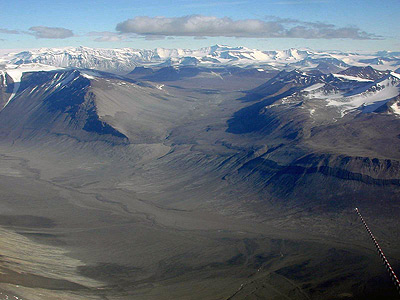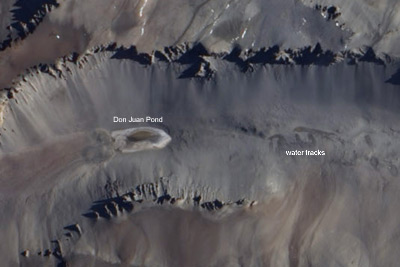Antarctica Facts and Pictures
Cool Fun Facts on the Antarctic
and South Pole
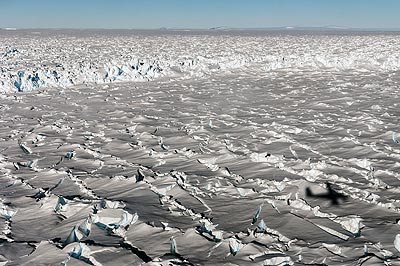 1/
If Antarctica's ice sheets melted, all of the worlds
oceans would rise by 60 to 65 meters (200 - 210ft)
- everywhere.
1/
If Antarctica's ice sheets melted, all of the worlds
oceans would rise by 60 to 65 meters (200 - 210ft)
- everywhere.
2/ Antarctica is pushed into the earth by the weight of its ice sheets.
If they melted, it would "spring
back" about 500m (1,625 ft). It would do
this v...e...r...y s...l...o...w...l...y
taking about 10,000 years.
In the
north Scotland
and Scandinavia are still rebounding today after the last
ice age - at the rate of 50cm a century in the Northern
Baltic - the fastest moving place.
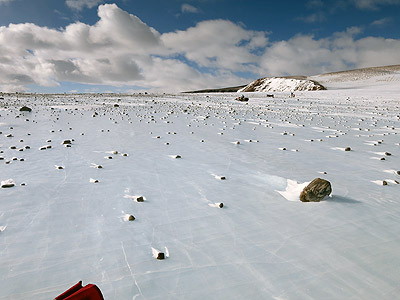 3/ Antarctica is the best place
in the world to find meteorites.
3/ Antarctica is the best place
in the world to find meteorites.
Dark meteorites show up against the white expanse of ice and snow and don't get covered by vegetation. In some places the way the ice flows concentrates meteorites there. The ice makes them gather in one place.
The picture shows
some meteorites, they are attempting to blend
in with some ordinary rocks as well, you need to know what
you're looking for.
4/ The cold and
dry conditions in the Dry Valleys region of Antarctica are
so close to those on Mars that NASA did testing
there for the Viking missions.
5/ There is a small lake in the Dry Valleys called Don Juan Pond that has the more concentrated salts than any other naturally occurring body of water on earth with 400g of solid per 1000g of pond water, the salts act as an anti-freeze and it remains liquid even at -30C!
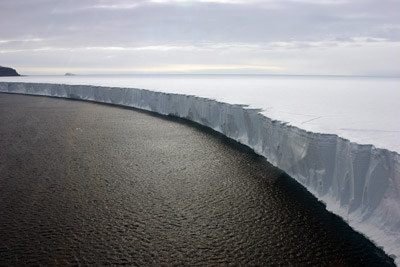 6/
One of the biggest
icebergs ever broke free from the Ross
ice shelf, Antarctica in 2000. Given the catchy
name, B-15, It was 295km (183 miles) long and 37km (23 miles)
wide, with a surface area of 11,000 sq km (4,250 square
miles) above water - and 10 times bigger below.
6/
One of the biggest
icebergs ever broke free from the Ross
ice shelf, Antarctica in 2000. Given the catchy
name, B-15, It was 295km (183 miles) long and 37km (23 miles)
wide, with a surface area of 11,000 sq km (4,250 square
miles) above water - and 10 times bigger below.
It was similar in size to The Gambia, Qatar, The Bahamas, Connecticut and some other places I'm not sure about but you might know. Over the next three years, it broke into several pieces called B-15A, B-15B etc. before eventually drifting north and melting.
Bonus fact!
- In 2005 the largest piece of B-15,
B15A (100km by 30km by then) was broken up further by an
ocean wave that originated more then 8,300 miles (13,500
km) away in the Gulf of Alaska during a huge storm. The
wave generated took 6 days to travel the length of the Pacific
Ocean to reach Antarctica where it broke the iceberg.
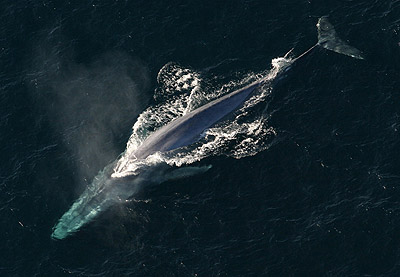 7/
It has been estimated that during the feeding season in
Antarctica, a full grown blue whale eats about
4 million
krill per
day (krill are small shrimp-like creatures), that's
3,600 kg or 4 tons - every day for 6 months.
Having laid down a layer of fat from this feeding activity
in Antarctica, they then starve for several months.
7/
It has been estimated that during the feeding season in
Antarctica, a full grown blue whale eats about
4 million
krill per
day (krill are small shrimp-like creatures), that's
3,600 kg or 4 tons - every day for 6 months.
Having laid down a layer of fat from this feeding activity
in Antarctica, they then starve for several months.
This daily intake would feed a human for about
4 years! If you could stomach it. Krill may be
nutritious but they're not very nice as people food - which
is lucky for the whales!
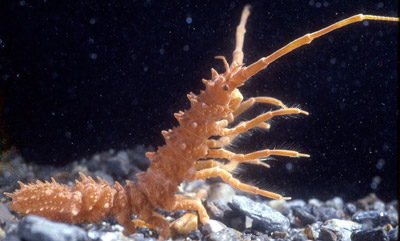 8/
The
Antarctic convergence is an upwelling of deep cold Antarctic
water in the ocean in a very rough circle around Antarctica,
it brings nutrients to the surface and forms a temperature
barrier. Since it arose about 20 million years ago, there
has been very little exchange of fish or other marine life
in either direction. This means that fish and other animals
have lived in their side of the ocean and have not crossed
over to their neighbours side.
8/
The
Antarctic convergence is an upwelling of deep cold Antarctic
water in the ocean in a very rough circle around Antarctica,
it brings nutrients to the surface and forms a temperature
barrier. Since it arose about 20 million years ago, there
has been very little exchange of fish or other marine life
in either direction. This means that fish and other animals
have lived in their side of the ocean and have not crossed
over to their neighbours side.
Antarctic marine organisms
have lived at between +2°C and
-2°C for 5 million years (-2°C is the freezing
point of sea water, below zero because of the salt). They
are therefore the best cold adapted animals that there are
on the planet - now or probably ever.
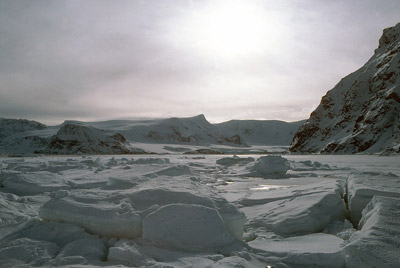 9/
A domestic deep freeze runs at about -20°C (-4°F). The
mean summer temperature on the great East Antarctica icecap
is -30°C (-22°F) and mean winter temperature around
-60°C (-76°F). That's a lot colder than
your freezer!
9/
A domestic deep freeze runs at about -20°C (-4°F). The
mean summer temperature on the great East Antarctica icecap
is -30°C (-22°F) and mean winter temperature around
-60°C (-76°F). That's a lot colder than
your freezer!
The lowest ever temperature recorded
was at the Russian Vostok station. It was
- 89.6°C (-129°F)
10/
When the
Antarctic
sea-ice begins to expand at the beginning
of winter, it advances by around 40,000 square miles (100,000
square kilometres) per day, and eventually doubles
the size of Antarctica, adding up to an extra 20 million
square kilometres of ice around the land mass.
That's
one and a half USA's, two Australia's or 50 UK's worth of
ice area that forms, then breaks up and melts every year.
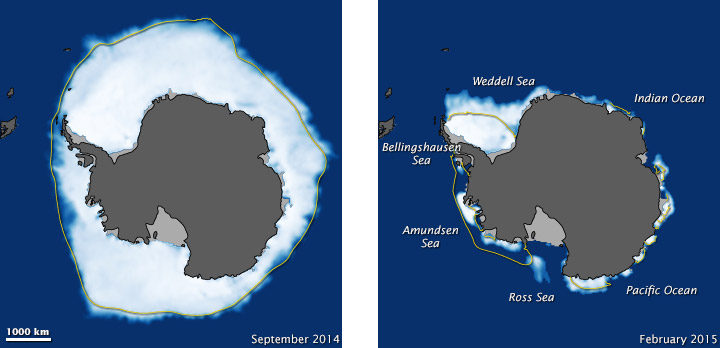
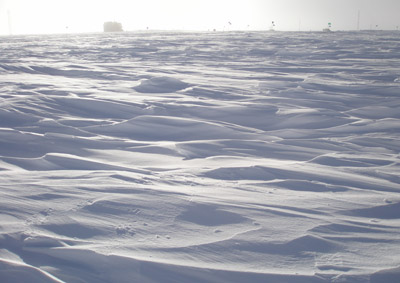 11/
Snow falling at the South Pole takes about 100,000 years
to
"flow" to the coast of Antarctica before
it drops off the end as part of an iceberg.
11/
Snow falling at the South Pole takes about 100,000 years
to
"flow" to the coast of Antarctica before
it drops off the end as part of an iceberg.
12/
The Antarctic ice cap has 29 million cubic kilometers of
ice. This is 90% of all the ice on the planet and
between 60 and 70 % of all of the world's fresh water. Only
about 0.4% of Antarctica is not covered by ice.
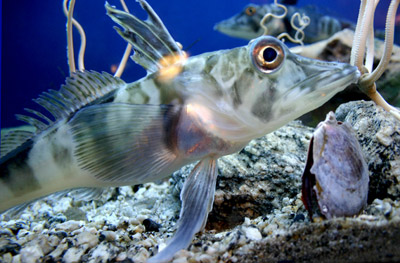 13/ Antarctica has a peculiar
group of fish called the ice fish. These have no
red pigment - haemoglobin - in their blood to carry oxygen
around.
13/ Antarctica has a peculiar
group of fish called the ice fish. These have no
red pigment - haemoglobin - in their blood to carry oxygen
around.
They get by perfectly well without it because
the temperature is so low and oxygen dissolves better in
cold temperatures. They just have a larger volume of clear
blood instead and this gives them an unusually ghostly
white colour, particularly their gills.
Recent research on the ice fish ahs shown that their DNA
can be damaged by high levels of ultra violet light coming
through the ozone hole. They have less pigment to stop the
UV getting through so it is more damaging - in a similar
way that fair skinned people get sunburnt more easily as
their skin is damaged by the uv in sunlight. Many
other Antarctic sea creatures including fish have antifreeze
in their blood so they don't accidentally get frozen solid!
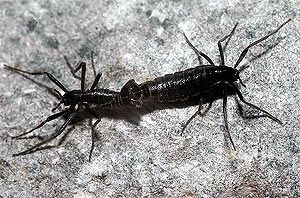 14/
The largest
land animal
in Antarctica is an insect, a wingless midge,
Belgica antarctica, less
than 13mm (0.5in) long.
14/
The largest
land animal
in Antarctica is an insect, a wingless midge,
Belgica antarctica, less
than 13mm (0.5in) long.
There
are no flying insects (they'd just get blown away), just
shiny black springtails that hop like fleas and often live
among penguin colonies.
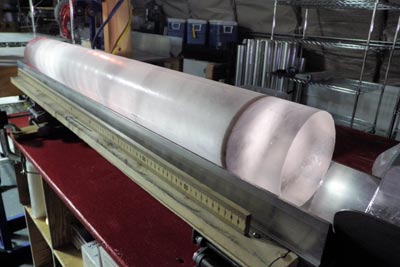 15/
Samples of ice known as ice cores are regularly bored out
of the ice in Antarctica by scientists. They are
removed as a long cylinder of ice that gives an indication
of the past going back tens and hundreds of thousands of
years. The properties of the ice, of dust trapped in the
ice, and even of air bubbles trapped in the ice give valuable
information about the earth's climate at various times in
the past.
15/
Samples of ice known as ice cores are regularly bored out
of the ice in Antarctica by scientists. They are
removed as a long cylinder of ice that gives an indication
of the past going back tens and hundreds of thousands of
years. The properties of the ice, of dust trapped in the
ice, and even of air bubbles trapped in the ice give valuable
information about the earth's climate at various times in
the past.
A glaciologist could easily give you a
drink of water that was frozen during the time of the Roman
Empire.
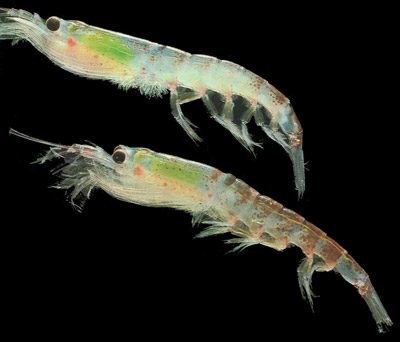 16/
A swarm of
krill
was tracked by scientists that was estimated at being up
to 10 million tonnes!
16/
A swarm of
krill
was tracked by scientists that was estimated at being up
to 10 million tonnes!
This is the equivalent of about 143 million people (at an average of 70kg each) or more than the entire populations of the UK and Germany combined (and wandering around together).
17/ Antarctica
is the only continent with no native species of ants or
reptiles.

